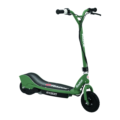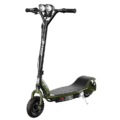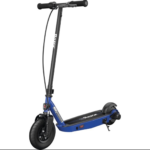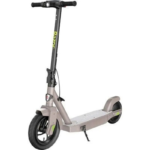- Home
- Scooters
- Electric Scooters
- Razor Sonic Glow
Razor Sonic Glow
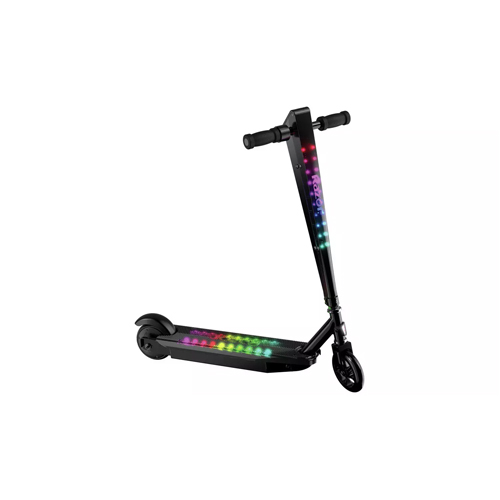

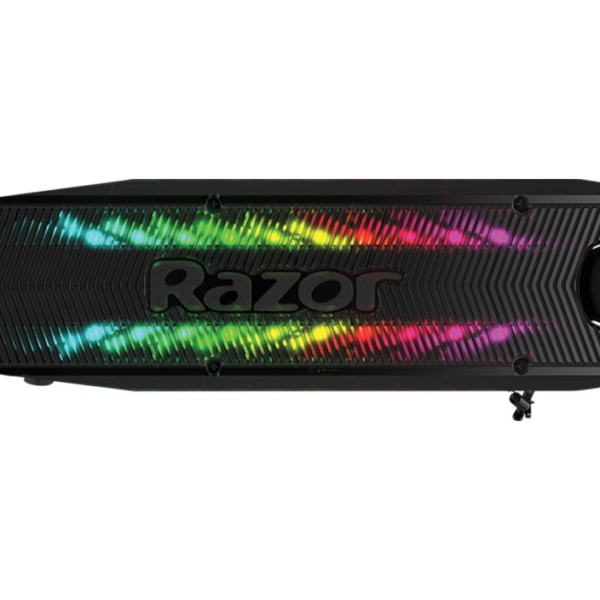
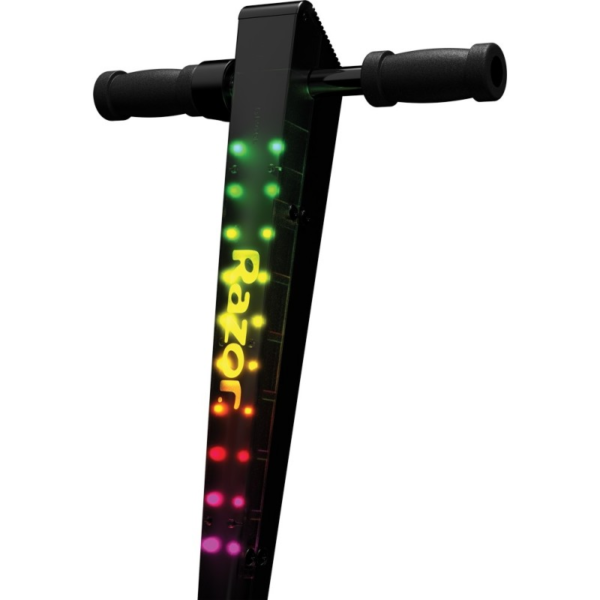
- Battery Range: 10 mi (16 km)
- Top Speed: 10 mph (16 km/h)
- Motor Power: 100 W nominal
- Weight Capacity: 120 lb (54 kg)
- Charging Time: ~6–8 h
- Scooter Weight: 26.5 lb (12.0 kg)
PROS
- Built-in audio + LEDs
- Kid-friendly speed cap
- Low-upkeep hub motor
- Solid, flat-resistant tires
- Stable low-deck stance
CONS
- Not for adults
- Short range vs commuters
- No suspension
- Lower weight capacity


Table of contents
- What Is the Razor Sonic Glow?
- How the Razor Sonic Glow Works
- Key Specifications
- Design & Build Quality
- Performance Fundamentals
- Battery, Range & Efficiency
- Ride Quality & Comfort
- Braking & Safety Features
- Portability & Daily Usability
- Maintenance & Care
- Weather & Seasonal Considerations
- Razor Sonic Glow vs Alternatives
- Who the Razor Sonic Glow Is (and Isn’t) For
- FAQs
- Glossary
- Design & Build Quality (Deeper Notes)
- Performance Fundamentals (Deeper Notes)
- Battery, Range & Efficiency (Deeper Notes)
- Ride Quality & Comfort (Deeper Notes)
- Braking & Safety (Deeper Notes)
- Portability & Daily Usability (Deeper Notes)
- Maintenance & Care (Deeper Notes)
- Weather & Seasonal (Deeper Notes)
- Final Verdict
The Razor Sonic Glow is a kid-friendly electric scooter built to make short rides fun, visible, and simple. It mixes a quiet rear-hub motor with a Bluetooth speaker and music-reactive LEDs. Consequently, young riders get a smooth cruise and a rolling light show. If you want an easy starter scooter for school runs, park loops, and neighborhood rides, this one fits the brief.
What Is the Razor Sonic Glow?
At its core, the Razor Sonic Glow is a compact, entry-level e-scooter for riders around age eight and up. It pairs a modest brushless hub motor with a sealed lead-acid battery and a simple thumb throttle. Because the design focuses on low speed and predictable controls, kids can learn quickly without feeling overwhelmed.
Additionally, the scooter leans into entertainment. It includes a built-in Bluetooth speaker and a deck-plus-stem LED array that pulses to your music. As a result, young riders are seen, heard, and excited to practice. Under the glow, the platform remains straightforward: a steel frame, a durable airless rear tire, a urethane front wheel, and a classic rear-fender brake.
In short, the Razor Sonic Glow balances approachable riding with show-time flair. It favors stability over speed, durability over delicacy, and routine use over heavy tuning.
How the Razor Sonic Glow Works
Think of it like a small, self-propelled skateboard with handlebars and a music system.
- Motor: A brushless, rear-hub motor sits inside the back wheel. Because it is hub-driven, there are no chains to adjust and no external gears to snag clothing. Therefore, power delivery feels linear rather than punchy, which builds confidence.
- Controller: The electronic “brain” manages when and how the motor adds torque. It’s tuned for kick-to-start. Consequently, the motor engages only after the rider pushes off and reaches a walking pace. That safety gate helps avoid sudden jolts.
- Battery: A 24-volt sealed lead-acid pack supplies the motor and lights. It’s rugged and predictable. However, it’s heavier than a lithium pack, though it tolerates kid use and simple charging habits.
- Throttle: A thumb-activated lever on the right grip tells the controller how much assist you want. Press lightly and it eases forward; press deeper and it holds a steady cruise. Meanwhile, the lever’s short throw keeps control intuitive.
- Brakes: A rear-fender brake provides mechanical stopping. Step on the fender, and the controller also cuts motor power. Therefore, stops feel clear and intuitive.
- Bluetooth & LEDs: Pair a phone or music player once. After that, the scooter reconnects automatically and syncs its multi-color LEDs to the beat. Moreover, the glow improves visibility in dim light.
Together, these pieces create a ride that starts with a kick, builds speed smoothly, and stops with a natural foot press. Consequently, beginners gain confidence fast.
Key Specifications
Note: This model uses a fixed stem and does not fold. Folded dimensions are not applicable.
| Block | Item | Detail |
|---|---|---|
| General | Intended rider | Ages 8+; beginner-friendly, neighborhood use |
| Max rider weight | 120 lb (54 kg) | |
| Top speed | Up to ~10 mph (16 km/h) | |
| Drive layout | Rear-wheel hub motor | |
| Performance & Power | Motor | 80-watt, brushless, kick-to-start hub |
| Throttle | Thumb-activated, single-mode cruise hold by finger pressure (no set-and-forget cruise control) | |
| Hill behavior | Best for gentle grades; expect slower climbs on longer hills | |
| Battery, Charging & Electrical | Battery | 24V sealed lead-acid (SLA), rechargeable |
| Claimed run time | Up to ~55 minutes per charge (continuous use) | |
| Charging | Wall charger included; typical full charge overnight | |
| Electrical safety | System certified to UL 2272 standards | |
| Lights & audio | Music-reactive LEDs (deck + stem), built-in Bluetooth speaker | |
| Build & Dimensions | Frame/fork | Steel |
| Deck | Textured plastic deck with embedded LEDs | |
| Wheels/tires | Front: spoked urethane; Rear: abrasion-resistant, airless/flat-free | |
| Assembled size | ~32.3″ L × 13.9″ W × 34.9″ H (about 82 × 35.5 × 88.7 cm) | |
| Folded size | Not applicable (non-folding stem) | |
| Weight | ~25.4 lb (≈11.5 kg) | |
| Safety & Control | Primary brake | Rear-fender foot brake with motor cut-off |
| Kick-to-start | Motor engages only after ~3 mph push-off | |
| Visibility | Multi-color LEDs increase conspicuity | |
| Water guidance | Avoid wet surfaces; no submersion or heavy rain use | |
| Features & Extras | Speaker | Bluetooth, ready-connect pairing (auto-reconnect) |
| Kickstand | Retractable | |
| Cruise Control | Not included (hold throttle to maintain speed) | |
| Warranty & Compliance | Warranty | Typical Razor limited warranty terms apply |
| Compliance | Electrical system UL 2272 compliant |
Design & Build Quality
Although the light show grabs attention, the frame under it matters most. The Sonic Glow uses a steel frame and fork, which feel sturdy for their size. Because steel can flex slightly under load, small bumps feel muted rather than harsh. Additionally, the deck is a molded plastic platform with non-slip texture and embedded LEDs. It cleans easily with a damp cloth.
The stem is a straight T-bar with foam grips. Height suits the intended age range, and the simple collar clamp keeps alignment solid when tightened correctly. Since there’s no folding joint to loosen or rattle, you hear fewer squeaks over time and spend less effort checking bolts. The trade-off, of course, is portability; a non-folding stem is bulkier in car trunks.
Fit-and-finish is consistent with kid-class scooters. Panel gaps are tidy. Moreover, the wiring for the Bluetooth module and stem lights is routed inside the bar, which protects the harness from fingers and snags. The retractable kickstand snaps up cleanly and holds the scooter at a stable lean when parked.
Performance Fundamentals
Acceleration Feel
After a push-off to walking speed, the hub motor engages smoothly. It doesn’t surge. Instead, it feeds torque in a predictable way, so new riders keep balance. On flat ground, the scooter cruises steadily without hunting. Furthermore, the thumb lever allows small speed corrections, which helps when riding near others.
Cruising Stability
Stability depends on wheelbase, handlebar height, and weight distribution. Here, the rear-wheel drive shifts some weight to the back. That improves straight-line tracking and traction. The front urethane wheel rolls freely on smooth paths and sidewalks. At top speed, the steering remains light, and wobble is uncommon when both hands are on the grips. Even so, riders should relax elbows and keep eyes ahead to stay centered.
Hill-Climb Behavior (~7–10% Grades)
Modest hills require patience. On short ramps or driveways, the scooter crests without drama. On longer 7–10% grades, speed drops, and lighter riders fare better. If the hill starts from a stop, give a firm kick before pressing the throttle. That approach helps the controller engage and hold momentum. Because this is an 80-watt drive, it’s built for gentle slopes, not sustained climbs. Therefore, plan routes with softer grades.
Battery, Range & Efficiency
Rated vs. Real-World Range
The rated ride time assumes uninterrupted cruising on flat ground with a lighter rider. In real use, frequent stopping, starts, and hills shorten range. Cooler temperatures do as well. As a practical estimate, expect a typical school-day loop or park ride to fit comfortably within a single charge for the intended rider size. Nevertheless, leave a little reserve for the return leg.
Factors That Affect Range
- Rider weight: Heavier riders work the motor harder; consequently, the pack drains faster.
- Terrain: Rough surfaces and inclines raise demand; therefore, smooth routes go farther.
- Tire type: The airless rear tire avoids flats but adds a touch of rolling resistance compared to a pumped pneumatic.
- Temperature: Cold slows chemical reactions in sealed lead-acid cells, which reduces output and trims runtime.
- Speed choice: Holding full throttle all the time consumes energy faster; easing off extends rides.
Charging Best Practices
Because the pack is sealed lead-acid, habits matter. Charge after rides. If the scooter sits for weeks, top it off monthly. Do not store in freezing conditions. Additionally, avoid complete depletion; running until the scooter crawls is tough on the pack. An overnight charge is a simple routine for families, and it keeps morning rides predictable.
Ride Quality & Comfort
Tires and Surface Feel
The front urethane wheel glides on smooth paths and feels efficient on polished sidewalks. The rear flat-free tire is tougher and shrugs off sharp debris that might puncture a tube. On coarse or cracked concrete, vibrations rise because there’s no suspension. Therefore, encourage riders to scan ahead, choose smoother lines, and bend knees slightly over seams. For comfort, a relaxed stance helps.
Ergonomics and Stance
The deck offers enough space for a comfortable stance with one foot ahead of the other. The foam grips are soft, which helps hands during longer loops. Because the scooter is sized for kids, the bar height feels natural for the recommended age range. However, taller teens may end up with a compressed elbow angle, which is fine for short hops but less ideal for long rides.
Stem Flex
Without a folding joint, the stem behaves as one strong column. There’s minimal flex during braking or quick steering inputs. Thus, the single-piece design builds confidence and extends the service life of the front end.
Braking & Safety Features
The rear-fender brake is simple and dependable. Step firmly, and you feel predictable deceleration. The motor’s power cut-off complements the mechanical action, so you never fight propulsion while stopping. Teach new riders to practice gentle squeezes with the throttle hand off. Because there’s no front brake, rear-biased stopping remains stable and less likely to pitch the rider forward.
Visibility is a highlight. The stem and deck LEDs pulse with your music, which makes the scooter stand out near dusk. Still, treat them as visibility aids rather than full headlights. Ride only where you can see the surface ahead. Reflectors are minimal, so a bright jacket or backpack helps during gray afternoons. Additionally, a well-fitting helmet is essential.
Finally, water is the enemy. The scooter is not designed for rain, standing water, or puddle splashes. Wet surfaces also reduce urethane grip. Therefore, keep rides dry and clean.
Portability & Daily Usability
This model weighs roughly 25 pounds. Most adults can lift it into a trunk without strain, yet kids will need help with stairs. Because the stem doesn’t fold, storage is vertical: lean it on the kickstand along a garage wall or in a hallway corner. For school routines, set a simple rule: park, flip the switch off, and hook the charger after homework. Consequently, mornings start with a full pack.
As for security, treat it like a bicycle. Bring it inside whenever possible. If you must leave it briefly at a park bench, keep it in sight. The deck lights draw attention, which is great for visibility but also for curious onlookers. Therefore, supervision matters.
Maintenance & Care
A little routine goes a long way. Here’s a simple schedule families can follow:
- Before each ride (30 seconds):
Check the bar clamp bolts for snugness. Spin the wheels for free rotation. Also, confirm the throttle snaps back cleanly. - Weekly:
Wipe the deck and stem with a damp cloth. Inspect the rear tire for embedded debris. Additionally, test the brake for firm response. - Monthly:
Check all visible fasteners for tightness with the supplied Allen key. Confirm the kickstand springs back. Moreover, top-off the battery even if you didn’t ride much. - Seasonally:
Inspect the front urethane wheel for flat spots. If kids have outgrown the bar height, consider retiring the scooter to a younger sibling rather than forcing an awkward stance. Likewise, review safe-riding rules.
There’s no chain to oil and no pneumatic tube to patch. Keep electrical parts dry, charge regularly, and store indoors. If a part wears out, the modular hub motor and front wheel are straightforward to replace with basic tools.
Firmware or App Habits
There’s no scooter firmware to update and no companion app to manage. The Bluetooth module is for audio only. Thus, ownership stays simple.
Weather & Seasonal Considerations
Rain
Avoid it. Water and electronics don’t mix, and wet urethane slides easily. If you’re caught by a light sprinkle, walk the scooter home. Then, dry it with a towel and let it sit inside before charging.
Heat
High heat can stress batteries. Do not leave the scooter in a hot car trunk for hours. If the deck feels very warm, let it cool before charging. Riders should also remember that soft asphalt increases rolling drag, which modestly trims range. Consequently, ride times may be shorter in midsummer.
Cold
Cold thickens internal battery chemistry and lowers available power. Expect less ride time on chilly mornings. Because traction also falls in the cold, slow down and give more space for braking. Additionally, charge indoors after the scooter reaches room temperature.
Dust and Debris
The airless rear tire shrugs off thorns and glass better than a tube. Even so, sharp gravel can chew urethane edges. Therefore, encourage kids to slow over gritty corners and avoid construction zones.
Razor Sonic Glow vs Alternatives
WitWithin kids’ scooters, models often fall into three broad classes:
- Entertainment-forward (like this one):
The Sonic Glow excels when you want music, lights, and a smooth introduction to e-mobility. It shines at evening park loops and neighborhood gatherings. Because the motor is quiet and the speed is capped, it keeps the focus on fun and control. Moreover, maintenance stays light. - Commuter-leaning kids’ models:
Some alternatives trade LEDs and speakers for slightly more range or a lightweight lithium pack. Those are better for longer school runs, but they may cost more and require stricter charge habits. Additionally, they can feel less playful. If that sounds right for you, consider the lightweight and range-oriented Segway Ninebot C2 Lite as a reference point. - Performance-tilted youth models:
A few kid-size scooters emphasize punchier acceleration. They climb short hills better and feel more “grown-up.” However, they can overwhelm absolute beginners and often ride harsher due to harder tires or tighter frames. Therefore, choose them only when skills are ready.
Because the Razor Sonic Glow emphasizes approachability, it’s best chosen for short to medium neighborhood rides rather than hilly routes or long daily commutes.
Who the Razor Sonic Glow Is (and Isn’t) For
Great for:
- Kids who want an exciting first e-scooter with lights and music.
- Short school runs on smooth sidewalks and paths.
- Flat neighborhoods where climbs are brief and gentle.
- Families who value simple charging and minimal tinkering.
Not ideal for:
- Steep, lengthy hills that demand more motor torque.
- Rainy regions where wet rides are common.
- Riders nearing or above the weight limit.
- Households that require a folding stem for tight storage.
Ultimately, if you prioritize predictable handling, fun visibility, and low-maintenance ownership, the Razor Sonic Glow fits well.
FAQs
1) How fast does it go, and how does it feel at speed?
It cruises up to about 10 mph. The steering stays light and stable, and the throttle makes fine adjustments easy. Additionally, two-handed grip keeps tracking straight.
2) Can the Sonic Glow climb hills?
Yes, gentle ones. On longer grades near 7–10%, speed will drop. A firm kick-off helps the motor hold momentum. Consequently, route choice matters.
3) Does it have regenerative braking?
No. Braking is mechanical through the rear-fender, and the system also cuts motor power when you step on it. Therefore, stops remain predictable.
4) Is there cruise control?
No. You maintain speed by holding the thumb throttle. That approach keeps control simple for beginners and avoids unintended lock-ins.
5) How should I charge and store it for the best battery life?
Charge after rides, top off monthly during storage, and keep it indoors. Avoid freezing temperatures and do not leave it in a hot car. Additionally, let a hot deck cool before charging.
6) Is the Bluetooth only for music?
Yes. It’s a ready-connect audio speaker. There’s no riding app or firmware to manage. As a result, setup stays easy.
7) Where can I find a quick Razor Sonic Glow overview of the main pros and cons?
Here it is: easy starting, smooth throttle, fun lights, low maintenance, and predictable speed. The trade-offs are modest hill power, a heavier battery, and a non-folding stem.
Glossary
- Ah (Amp-hour): A measure of how much charge a battery can store. More Ah usually means more ride time.
- Wh (Watt-hour): Battery energy (volts × amp-hours). It reflects total stored energy more directly.
- Brushless Motor: A motor without brushes, which reduces friction and maintenance.
- Controller: The electronics that translate throttle input into motor power.
- Kick-to-Start: A safety feature that requires a push-off before the motor engages.
- Hub Motor: A motor built into the wheel hub; quiet, sealed, and low-maintenance.
- Sealed Lead-Acid (SLA): A rugged battery type that’s heavier than lithium but predictable and affordable.
- Regen (Regenerative Braking): A system that recovers energy while braking. Not used on this model.
- Rear-Fender Brake: A foot-operated brake that presses on the rear wheel or hub.
- Stem Flex: Slight elastic movement in the handlebar stem under load; minimal here due to a fixed stem.
- UL 2272: A safety standard for electrical systems in personal e-mobility devices.
- Urethane Wheel: A hard, smooth wheel that rolls efficiently on clean, flat surfaces.
- Flat-Free Tire: An airless tire that cannot puncture; adds durability and consistency.
- Top Speed: The maximum cruising speed on level ground with a light rider and a full battery.
- Cut-Off Switch: Electronic feature that stops motor power when the brake is applied.
Design & Build Quality (Deeper Notes)
For families comparing options, a few details stand out:
- No folding joint: Many kids’ scooters develop play in folding latches. This one avoids that entirely. You trade compact storage for long-term solidity.
- Wire routing: The stem contains the LED and Bluetooth loom. Because the harness is internal, it resists snagging and weather splashes better than external runs.
- Deck maintenance: The LED deck lens wipes clean and resists shoe scuffs. Avoid harsh solvent cleaners; a damp cloth works best. Additionally, regular wipe-downs maintain brightness.
Performance Fundamentals (Deeper Notes)
- Throttle learning curve: Riders often master smooth starts by counting “one-and-kick, two-and-press.” That rhythm syncs the kick-to-start with the throttle press. Furthermore, it prevents abrupt launches.
- Handling on seams: Approach expansion joints at a slight diagonal and with soft knees. This technique reduces the “thunk” feeling on hard urethane. Additionally, it keeps hands relaxed.
- Top-speed corners: Encourage riders to ease off the throttle before tight turns. Rolling back on the lever after the apex keeps the line tidy and stable.
Battery, Range & Efficiency (Deeper Notes)
- Trip planning: A 20–30 minute after-school ride is a nice target. It leaves reserve for the next outing if you forget to charge.
- Charge timing: Overnight charging sets a habit. Make it part of the evening routine to keep mornings simple. Moreover, consistent charging supports battery health.
- Storage state: For sealed lead-acid, storing fully charged is better than half-charged. Therefore, top off before long breaks.
Ride Quality & Comfort (Deeper Notes)
- Foot placement: Lead foot forward, rear foot across the deck. That stance stabilizes hips and improves steering precision.
- Grip comfort: Replace grips if they tear. Foam grips are inexpensive and easy to swap. Additionally, fresh grips improve control.
- Noise: Without chains or belts, mechanical noise is low. Most sound comes from wheel contact and, of course, your music.
Braking & Safety (Deeper Notes)
- Practice plan: In an empty lot, set cones or chalk lines. Practice stops from slow, medium, and near top speed. Vary foot pressure to learn modulation. Consequently, riders build brake feel before real-world rides.
- Visibility habits: The LEDs help, but bright clothing and a helmet are essential. Moreover, ride in daylight whenever possible.
- Surface scanning: Teach riders to look 10–15 yards ahead. Early spotting of rough patches prevents last-second swerves and panic stops.
Portability & Daily Usability (Deeper Notes)
- Carrying tips: Adults should lift with two hands—one on the bar, one under the deck. Additionally, keep the scooter centered to avoid twisting.
- Home storage: A wall-mounted hook at kid height can keep the scooter tidy and off the floor. Therefore, hallways stay clear.
- Neighborhood etiquette: Keep music volume friendly. The speaker is fun, but be considerate in shared spaces.
Maintenance & Care (Deeper Notes)
- Fasteners: When checking bolts, snug is enough. Do not overtighten the collar clamp. Otherwise, you may crush spacers.
- Front wheel wear: Urethane can develop “flat spots” from hard braking or skids. Replace if you feel rhythmic thumps. Additionally, discourage long skids.
- Rear hub: If acceleration feels uneven after many months, inspect motor cabling at the deck connection for looseness.
Weather & Seasonal (Deeper Notes)
- Autumn leaves: Wet leaves are slippery. Even dry piles can hide sticks that jar the front wheel. Therefore, slow before leaf patches.
- Winter storage: Bring the scooter indoors. Charge once a month to prevent the battery from drifting down.
- Spring checks: After storage, do a full fastener pass, test the brake cut-off, and re-pair Bluetooth if needed. Additionally, refresh helmet fit.
Final Verdict
The Razor Sonic Glow succeeds by making first rides easy and exciting. It starts safely with kick-to-start logic and rolls quietly thanks to a brushless hub. The glow and music turn a plain ride into a mini event, which keeps kids motivated to practice. Maintenance is light, daily use is simple, and the fixed stem avoids play and creaks.
It is not a hill crusher or a long-range commuter. Yet it doesn’t try to be. Instead, it prioritizes predictable control, visibility, and fun within short to medium neighborhood loops. For families seeking a confidence-building first e-scooter with personality, the Sonic Glow checks the key boxes. Moreover, its straightforward design keeps ownership relaxed.
Specifications
General
| Model The Model specifies the exact version or name of the scooter. It helps identify its unique design, features, and specifications within the manufacturer’s product line. Knowing the model makes it easier to compare options, find compatible accessories, or look up support information. | Sonic Glow |
| Brand The Brand identifies the manufacturer or company that designs and produces the scooter. A trusted brand is a sign of quality, reliability, and good customer support. Well-known brands often have higher standards for safety, performance, and after-sales service, giving you more confidence in your purchase. | Razor |
| Release Date The Release Date indicates when the scooter model was officially launched on the market. This helps you know how current the design, technology, and features are. A newer release date often means updated components, improved performance, and the latest safety or smart features. | 17 November 2025 |
| Recommended Age Recommended Age indicates the minimum age range that the scooter is designed for, based on safety, size, and ease of use. Following the recommended age helps ensure that riders can handle the scooter’s speed, weight, and controls comfortably and safely. Always check local laws and use protective gear, especially for younger riders. | Recommended 8+ |
Performance & Power
| Motor Power (Wattage) What it means: The motor power, measured in watts (W), shows how strong the scooter’s electric motor is. Why it matters: Higher wattage usually means better acceleration, more torque, and improved performance on hills or rough terrain. For example, a 250W motor is good for flat city roads and light riders, while a 500W or 1000W motor provides more power for faster speeds or climbing steep inclines. | 100 W nominal (Power Core) |
| Top Speed The Top Speed indicates the maximum speed that the scooter can reach under optimal conditions. It’s usually measured on level ground with a fully charged battery and an average rider weight. A higher top speed allows you to travel longer distances faster, but always ensure you ride within legal speed limits and your personal comfort zone for safety. | 10 mph (16 km/h) |
| Battery Capacity Battery Capacity refers to the total amount of energy the scooter’s battery can store, usually measured in ampere-hours (Ah) or watt-hours (Wh). A higher battery capacity means you can ride longer distances on a single charge, reducing the need for frequent recharging. Keep in mind that actual range can vary depending on rider weight, terrain, speed, and weather conditions. | 24 V 5 Ah class |
| Estimated Range per Charge The Estimated Range per Charge indicates the average distance the scooter can travel on a single full battery charge. This range is calculated under optimal conditions, such as flat terrain, moderate speed, and average rider weight. Real-world range may vary depending on riding style, terrain, weather, and load. A longer range means fewer recharges and greater freedom for longer trips. | Up to 10 mi (16 km) |
| Hill Climb Ability Hill Climb Ability describes the maximum incline or slope that the scooter can handle while maintaining stable performance. It’s typically expressed as a percentage or in degrees. A higher hill climb rating means the scooter can tackle steeper hills without losing too much speed or power. Actual climbing performance may vary based on rider weight, battery charge, and terrain conditions. | Gentle slopes |
| Drive System The Drive System refers to how power from the motor is delivered to the wheels. Electric scooters typically use either a hub motor (directly integrated into the wheel) or a chain/belt drive system. A high-quality drive system ensures smooth acceleration, efficient power transfer, and low maintenance. The choice of drive system affects performance, noise level, and overall ride experience. | Rear hub motor (RWD) |
Charging & Electrical
| Charging Time Charging Time indicates how long it takes to fully recharge the scooter’s battery from empty to 100% using the standard charger provided. Faster charging means less downtime and more time on the road. Actual charging time may vary slightly depending on battery capacity, charger output, and environmental conditions. | Approx. 6–8 hours |
| Battery Type Battery Type refers to the specific technology used in the scooter’s battery, which affects performance, lifespan, weight, and charging time. Most modern electric scooters use high-quality lithium-ion (Li-ion) batteries because they offer a good balance of energy density, durability, and low maintenance. A reliable battery type ensures consistent power delivery and longer riding ranges. | SLA/Li-ion by variant |
| Removable Battery A Removable Battery means the battery pack can be easily detached from the scooter for convenient charging and replacement. This feature allows you to charge the battery separately, swap it with a spare for extended range, or securely store it indoors in extreme weather. Removable batteries add flexibility and make it easier to keep your scooter powered up wherever you are. | No external fast charge |
| Regenerative Braking Regenerative Braking is an energy-saving feature that converts some of the energy normally lost during braking back into battery power. When you slow down or brake, the motor works in reverse to generate electricity, which helps extend the scooter’s range and improves overall efficiency. This system also reduces wear on traditional brake components, leading to lower maintenance over time. | Electronic front assist |
| Lighting Lighting refers to the built-in front and rear lights that enhance visibility and safety when riding in low-light conditions or at night. Good lighting helps you see the road ahead and ensures that other road users can see you. Many scooters include LED headlights, taillights, and sometimes brake lights or side reflectors for added safety and compliance with local traffic regulations. | LED lighting + speakers |
Build & Dimensions
| Scooter Weight Scooter Weight refers to the total weight of the scooter when fully assembled, including the battery. This affects how easy it is to carry, lift, and store the scooter when not in use. A lighter scooter is more portable and convenient for commuting, especially if you need to carry it upstairs or onto public transport. Keep in mind that a sturdy frame and quality components may add to the weight but also contribute to better durability and ride stability. | 26.5 lb (12.0 kg) |
| Maximum Rider Weight Maximum Rider Weight indicates the highest rider weight that the scooter is designed to safely support while maintaining optimal performance and stability. Staying within this limit helps ensure reliable acceleration, braking, and climbing ability, and it protects the frame, suspension, and motor from excessive strain. Exceeding the recommended limit may reduce performance and increase wear on components. | 120 lb (54 kg) |
| Deck Size Deck Size refers to the dimensions of the scooter’s standing platform. A wider and longer deck provides more foot space, allowing you to stand comfortably and adjust your stance while riding. A well-sized deck improves balance and stability, especially on longer rides or at higher speeds. Compact decks, on the other hand, help keep the scooter lightweight and portable. | Low deck; narrow stance |
| Handlebar Height Handlebar Height refers to the distance from the deck to the handlebars, which affects your riding posture and comfort. An appropriate handlebar height helps you maintain good balance, reduces strain on your back and arms, and makes steering more comfortable. Some scooters have adjustable handlebars to fit riders of different heights, while others have a fixed height for a streamlined design. | Kid-height bars |
| Folding Mechanism The Folding Mechanism describes how easily and securely the scooter can be folded for carrying and storage. A well-designed folding system lets you quickly collapse the scooter into a compact size, making it convenient to transport on public transit, store under a desk, or fit into a car trunk. Look for sturdy latches and safety locks to ensure the scooter stays firmly in place when folded or unfolded. | Simple folding latch |
| Dimensions Folded Dimensions indicate the size of the scooter when it’s fully folded. This measurement shows how much space the scooter will take up when stored or carried, making it easier to check if it will fit in your car trunk, under a desk, or in a closet. Compact folded dimensions are ideal for commuters who need to bring their scooter on public transport or store it in tight spaces. | 36.0 × 14.0 × 15.0 in (folded) |
| Material Material refers to the primary construction materials used for the scooter’s frame and key components. High-quality materials like aircraft-grade aluminum, reinforced steel, or durable composites provide strength, stability, and a lighter overall weight. A sturdy material ensures the scooter can handle daily wear and tear while maintaining safety and performance. | Aluminum/steel mix |
Safety & Control
| Brake Type(s) Brake Type(s) describe the braking systems the scooter uses to help you slow down or stop safely. Common brake types include mechanical brakes (like drum or disc brakes), electronic brakes, and foot brakes. Many scooters combine multiple braking systems for added safety and shorter stopping distances. The type and quality of brakes affect your control, especially when riding at higher speeds or on slopes. | Front electronic + rear foot |
| Suspension Suspension refers to the system that absorbs shocks and vibrations while riding, providing a smoother and more comfortable ride over uneven or rough surfaces. Scooters may have front suspension, rear suspension, or dual suspension for better shock absorption and stability. Good suspension helps reduce rider fatigue and improves control, especially when riding on bumpy roads or off-road paths. | None |
| Tire Type Tire Type refers to the kind of tires the scooter uses, which directly affects ride comfort, traction, and maintenance. Common types include solid (airless) tires, pneumatic (air-filled) tires, or hybrid options. Pneumatic tires offer better shock absorption and a smoother ride on rough surfaces, while solid tires are puncture-proof and require less upkeep. The right tire type helps ensure safe handling and a comfortable ride in different conditions. | Urethane/TPU solid |
| Tire Size Tire Size indicates the diameter and width of the scooter’s tires, which affect ride comfort, stability, and how well the scooter handles different terrains. Larger tires generally offer better shock absorption and a smoother ride over bumps and rough surfaces, while smaller tires keep the scooter lighter and more portable. Choosing the right tire size helps ensure a balance between agility and comfort. | 6–8 inch class |
| Kickstand The Kickstand is a built-in stand that allows you to park your scooter upright when it’s not in use. A sturdy kickstand keeps the scooter stable and prevents it from tipping over, protecting it from scratches and damage. It also makes storing and accessing your scooter more convenient, whether you’re at home, work, or on the go. | Side kickstand |
| Water Resistance Rating Water Resistance Rating indicates how well the scooter is protected against water and moisture, usually shown as an IP (Ingress Protection) rating. This rating helps you understand whether the scooter can handle light rain, splashes, or wet roads without damage. While most scooters are not fully waterproof, a good water resistance rating adds peace of mind when riding in changing weather conditions. Always avoid deep puddles or submerging the scooter to protect its electrical components. | IPX4 body |
Features & Extras
| Display/Console The Display (or Console) shows important real-time information about your ride, helping you monitor your scooter’s status at a glance. Typical displays show speed, battery level, distance traveled, and riding mode. Some models also include additional features like Bluetooth connectivity, app integration, or backlighting for better visibility at night. A clear and easy-to-read display enhances safety and convenience on every trip. | LED dashboard |
| Ride Modes Ride Modes refer to the different speed and power settings you can choose to match your riding style or road conditions. Common modes include eco for maximum range and energy efficiency, standard for everyday balance, and sport or turbo for higher speed and stronger acceleration. Switching between ride modes allows you to customize performance, conserve battery, and ride safely in various environments. | Beginner, Standard |
| Smart App Connectivity Smart App Connectivity lets you pair your scooter with a dedicated mobile app via Bluetooth. Using the app, you can monitor real-time ride stats like speed, battery level, and range, adjust settings such as ride modes or cruise control, lock the scooter for added security, and sometimes receive firmware updates. This feature adds convenience and allows you to personalize your riding experience right from your smartphone. | App-free basic operation |
| Anti-Theft System The Anti-Theft System helps protect your scooter from unauthorized use or theft. This feature can include built-in alarms, electronic motor locks, GPS tracking, or remote locking through a mobile app. A good anti-theft system provides peace of mind when parking your scooter in public spaces, adding an extra layer of security to safeguard your investment. | N/A |
| Cruise Control Cruise Control allows you to maintain a steady speed without continuously holding the throttle. This feature makes longer rides more comfortable by reducing hand fatigue and providing a smoother, more relaxed riding experience — especially on flat, open roads or bike lanes. For safety, cruise control can usually be easily activated or deactivated while riding. | No (region-dependent) |
| Accessories Included Accessories Included lists the additional items that come with the scooter to enhance your riding experience and convenience. Common accessories may include a charger, kickstand, bell, lights, phone holder, or carrying strap. These extras add value by making your scooter safer, easier to use, and ready to ride straight out of the box. | Bell, reflectors, charger |
Warranty & Compliance
| Warranty Period The Warranty Period indicates how long the manufacturer guarantees the scooter against defects in materials and workmanship under normal use. A good warranty provides peace of mind, showing the brand’s confidence in its product quality. Always check what parts are covered, such as the frame, battery, and motor, and follow the maintenance guidelines to keep your warranty valid. | 12 months typical |
| Certifications Certifications confirm that the scooter meets specific safety, quality, and environmental standards set by recognized organizations or regulatory bodies. Common certifications may include CE, RoHS, UL, or other local compliance marks, depending on your region. These certifications ensure that the scooter is manufactured to high standards and is safe and legal to use in your country. | Local e-scooter compliance |
Price Comparison




